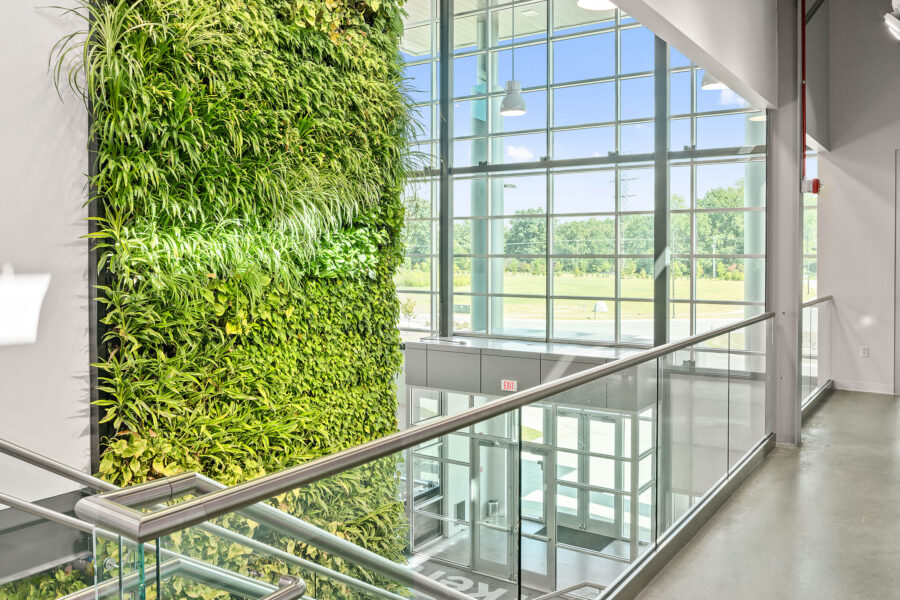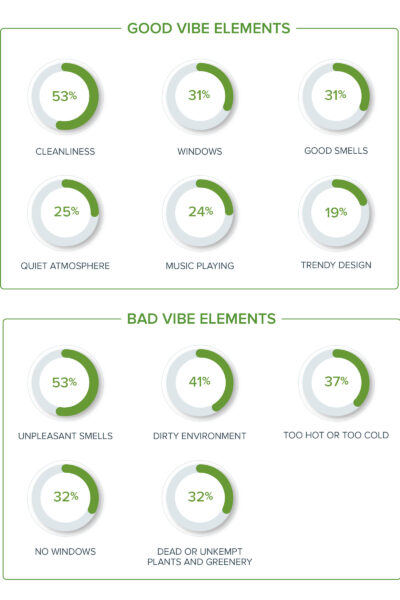Story at a glance:
- “Vibes” may feel like a slang term, but for consumers, vibes are very serious and can make or break whether someone returns to your space.
- The latest consumer research from Ambius shows the principles of biophilic design play directly into how visitors to your establishment feel about its vibes.
Ever walk into a business, building, or room and get a gut feeling before you even interact with an employee or another person?
Whether you instantly felt at home, unwelcomed, energized, or sophisticated, your subconscious was likely reacting to elements of the environment. In modern parlance, you were picking up on the “vibes” of that space. Architects and designers have a huge role to play in setting the stage for good vibes that keep people coming back to a place over and over again, as evidenced by new consumer research from Ambius.
What Consumers Have to Say About Vibes

This moss and living plant green wall paired with wood paneling and organic patterned flooring is a great example of a natural element. Photo courtesy of Ambius
Vibes isn’t just a slang term. It’s a general sense of environment, atmosphere, and feelings consumers take seriously. In fact, in a recent Ambius survey of 3,000 North American adults ranging in age from 18 to 77, 83% say vibes are very or moderately important to their overall enjoyment of a space, making vibes critical to the overall customer and brand experience.
Vibes can have a tangible impact on a business in terms of return traffic and sales. More than three out of every four respondents (83%) said they strongly or somewhat agreed they would go back to a place if they’d picked up a good vibe. Slightly less, 81%, strongly or somewhat agreed they would not return to a place if they picked up a bad vibe. Millennials were the most likely not to return, with more than half saying bad vibes would keep them away.
But the misery doesn’t stop there. Bad vibes, it seems, are contagious. More than one-third of respondents (35%) said if they had a bad experience at a business, they would actively dissuade others from visiting that business. Gen Z and Millennials were slightly more likely than their Gen X and Baby Boomer counterparts to engage in dissuading their peers; however, older generations were more likely to post a negative online review.
First impressions are critical because people make decisions about the vibes of a business quickly. More than one out of every two people (58%) say they can establish the vibes of a business within 20 minutes.
Given that vibes can be subjective, how can a business set the vibe from the second someone walks in the door? That’s where architects and designers can make a considerable difference.
Vibing with Biophilic Design

A large living green wall paired with floor to ceiling windows brings life to a commercial space. Photo courtesy of Ambius
Biophilic design is the process of creating environments that allow people to reconnect with nature in the built environment. It does so by using holistic design strategies that combine vegetation, scents, light, the acoustic environment, color, texture, daylight, fresh air, and views of outdoor green spaces in a way that physical and psychological comfort are improved. These strategies have been proven to have a positive impact on brand perception, mental health, well-being, productivity, mood, and more.
It should come as no surprise principles of biophilic design align with elements people say instill a space with good vibes, boosting the likelihood of a positive brand experience and increased customer satisfaction.
Ambius is guided by eight features of biophilic design that strengthen the human-nature connection. As we think about creating a positive, engaging atmosphere—aka good vibes—it’s worth reviewing them:
1. Scattered and clustered vegetation, varying height, distribution, randomness. Use a variety of plant species, different heights and forms, grouped together, and visible from near and far.
2. Dynamic and diffuse light, shadows. Incorporate natural and decorative lighting into design to allow people to experience light as they would outside. Make use of natural shadows and position decor to help increase shadow and to diffuse lighting.
3. Natural and local materials. Instead of synthetic materials, rely on wood, stone or ceramic finishes and natural accessories throughout a space.
4. Water. Adding water features, the sounds of running or splashing water, views of exterior water features, and pictures of waterbodies can add calm and connect people with nature.
5. Natural scents and odors. Infuse light, pleasant odors into spaces with transient occupancy to enhance emotions, spur desired actions, or form positive brand associations.
6. Refuge and shelter. Create a sense of protection through the use of design, plants, and temporary structures. This may include plants and trees with sheltering foliage, arching fronts, privacy-providing hedges, and green walls, or the addition of arbors and pergolas.
7. Connections between the interior and exterior. Use interior plants so that they align with exterior plant styles or naturally occurring landscapes, including visually through windows. Introduce natural sounds, such as birdsong.
8. Positioned at height and overlooking the landscape. Use design to create the feeling of being outdoors while inside. Create the illusion of height by using tall plants near where people are present and shorter plants further away.
Finding ways to utilize these principles throughout a space can establish a great first impression and help to sustain engagement and positive brand experiences throughout the duration of an individual’s time in a space.
The Generational Complexities of Good and Bad Vibes

Image courtesy of Ambius
Consumers have strong feelings about what specific elements create vibes, but there are also generational preferences that need to be taken into account. Depending on the people visiting your space, that may mean leveraging biophilic design for multipurpose needs.
Ambius presented survey respondents with a list of 13 elements and asked them to choose three that they felt were essential to establishing good vibes. There were clear leaders across all age groups: Cleanliness (53 percent), windows (31 percent), and good smells (31 percent).
Nearly two-thirds of Baby Boomers selected cleanliness, while only half of Millennials, and even fewer Gen Z respondents did (40%). Meanwhile, trendy design was more important to younger generations, with more than one quarter (26%) of Gen Z respondents and 23% of Millennial respondents choosing this as a top three element. Comfortable temperature was also more important to Gen X (19%) and Baby Boomers (24%).
When asked what specific design elements gave off the best vibes, decorative plants edged out wood elements by a narrow margin. Minimalism and white walls ranked highly, too. The use of geometric shapes was more pleasing to Gen Z and Millennials. High-end touches like leather upholstery and marble, also scored more favorably with younger generations. Gen X and Baby Boomers preferred more natural elements like water features and green walls.
Given 10 negative elements, unpleasant smells were the most likely to give bad vibes overall, with over half of respondents (53%) choosing this as one of their top three. Surprisingly, this outranked a dirty environment, which came in second at 41%. Temperature comfort level was next, with 37% reporting that being too hot or too cold can lead to bad vibes. Nearly one-third of respondents (32%) said that dead or unkempt plants would be a detractor for them.
For Gen Z and Millennials, a space with no windows gave off more bad vibes than it did for Gen X and Baby Boomers. Older generations were more likely to rank elements that negatively impact comfort as giving bad vibes, such as cramped or crowded spaces or inadequate seating.
4 Tips for Good Vibes

Plant immersion is seen here at The Puttery. Photo courtesy of Ambius
It’s easy to see how these elements can fit in with the principles of biophilic design. However, given consumer preferences, designing spaces that speak to all generations can be more challenging. But that doesn’t mean architects and designers should scale back and aim for neutrality over bold features and character. Instead look for ways to meet the needs of all who enter a space. Ambius recommends these four tips for establishing good vibes that speak to everyone.
Know your audience. Gone are the days of monotone sameness. To truly create a good vibe, architects and designers should understand the principal occupants or users of a space and incorporate biophilic design elements to enhance their engagements with a space. Consider generational differences and preferences as you develop your space.
Use windows to open your space. Windows and the light they let in are important to set the tone with both employees and consumers. Exposure to daylight, especially when many of us are inside for the better part of the day, is important for both physical and mental health. Windows can also make small spaces feel bigger and help large spaces inspire awe.
Amplify your experience with scent. Pleasant smells and aromas play a critical role in establishing a good vibe for visitors. Scent is one of our most powerful senses and is intrinsically linked to emotion and memory. Ambient scenting can help enhance the way people experience your space and forge strong connections to your brand. Scents can evoke a sense of cleanliness, freshness, relaxation, and more.
Don’t skimp on plants. With decorative plants ranking the highest of specific design elements likely to give good vibes, incorporating greenery and vegetation into your space should be paramount. Ensure you have plant care knowledge and manpower or contract with a company that can do it for you—dead or wilting plants send the wrong message.
Architects and designers have a significant amount of influence on the end customer experience. Use this latest consumer research to stress the importance of biophilic design with your partners. Whatever space you’re creating, don’t discount the power of those gut instinct vibes to turn your customers, employees, and guests into raving fans of a brand.


